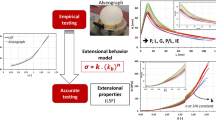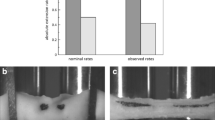Abstract
In this work, we investigate the large amplitude oscillatory shear (LAOS) behavior of white-wheat, wholegrain-wheat and chickpea flour doughs experimentally and theoretically. In order to accurately model the LAOS behavior of those doughs, it was important to study their linear viscoelastic as well as stress relaxation behaviors. We analyzed the linear viscoelastic behavior theoretically through the single spring-pot model, the fractional Maxwell model (FMM) and the fractional Kelvin-Voigt model. We found that the FMM is best suited to describe the LVE of the doughs we investigated. The damping function form was chosen based on stress relaxation and strain sweep experiments. We found that the Soskey-Winter (SW) equation is suitable for accurately describing the damping behavior of doughs. The LAOS experimental results were obtained at a set of strain amplitude and frequency values to build the Lissajous-Bowditch curves in Pipkin space. We modeled the LAOS stress response using the Kay-Bernstein Kearsley and Zapas (K-BKZ) model coupled with the FMM and SW models. The SW parameters were optimized for each dough by fitting the LAOS Lissajous-Bowditch curves in Pipkin space. The obtained fits to LAOS stress response were very good and illustrate that the FMM-SW-K-BKZ model provides an excellent description of the LAOS behavior of the different variety of doughs examined in this work. Moreover, the study shows that LAOS Lissajous-Bowditch curves provide characteristically different shapes for wheat and chickpea flour doughs.












Similar content being viewed by others
References
AACC (2000) Approved methods of the AACC, 10th edition. American Association of Cereal Chemists, St. Paul
Almusallam AS, Ahmed J, Nahar S, Chacko S (2016) Oscillatory shearing behavior of rocket leaves powder incorporated dough. Korea-Australia Rheol J 28:149–158
Almusallam AS, Zafar TA, Sidhu JS (2022) Oscillatory and thermo rheological studies of wheat and chickpea flour blended doughs for producing Arabic flat bread. J Eng Res. https://doi.org/10.36909/jer.15023
Amirkaveei S, Dai SMN, Qi F, Shahedi M, Tanner RI (2009) A comparison of the rheology of four wheat flour doughs via a damage function model. Appl Rheol 19:34305
Bernstein B, Kearsley E, Zapas L (1963) A study of stress relaxation with finite strain. Transac Soc Rheol 7:391–410
Bonfanti A, Kaplan JL, Charras G, Kabla A (2020) Fractional viscoelastic models for power-law materials. Soft Matter 16:6002–6020
Burnham KP, Anderson DR (2004) Multimodel inference: understanding AIC and BIC in model selection. Sociol Methods Res 33:261–304
Caputo M (1967) Linear models of dissipation whose Q is almost frequency independent—II. Geophys J Int 13:529–539
Chakrabarti-Bell S, Bergström J, Lindskog E, Sridhar T (2010) Computational modeling of dough sheeting and physical interpretation of the non-linear rheological behavior of wheat flour dough. J Food Eng 100(2):278–288
Ewoldt RH, Hosoi AE, Mckinley GH (2008) New measures for characterizing nonlinear viscoelasticity in large amplitude oscillatory shear. J Rheol 52:1427–1458
Faber T, Jaishankar A, Mckinley G (2017a) Describing the firmness, springiness and rubberiness of food gels using fractional calculus. Part II: measurements on semi-hard cheese. Food Hydrocoll 62:325–339
Faber T, Jaishankar A, mckinley g H (2017b) Describing the firmness, springiness and rubberiness of food gels using fractional calculus. Part I: theoretical framework. Food Hydrocoll 62:311–324
Faridy J-CM, Stephanie C-GM, Gabriela M-MO, Cristian J-M (2020) Biological activities of chickpea in human health (Cicer arietinum L.). A review. Plant Foods Hum Nutr 75:142–153
Gabriele D, DE Cindio B, D'antona P (2001) A weak gel model for foods. Rheol Acta 40:120–127
Hicks CI, See H, Ekwebelam C (2011) The shear rheology of bread dough: modeling. Rheol Acta 50:701–710
Hyun K, Wilhelm M, Klein CO, Cho KS, Nam JG, Ahn KH, Lee SJ, Ewoldt RH, Mckinley GH (2011) A review of nonlinear oscillatory shear tests: analysis and application of large amplitude oscillatory shear (LAOS). Prog Polym Sci 36:1697–1753
Jaishankar A, Mckinley GH (2013) Power-law rheology in the bulk and at the interface: quasi-properties and fractional constitutive equations. Proc Royal Soc A: Math, Phys Eng Sci 469:20120284
Jaishankar A, Mckinley GH (2014) A fractional K-BKZ constitutive formulation for describing the nonlinear rheology of multiscale complex fluids. J Rheol 58:1751–1788
Jóźwiak B, Orczykowska M, Dziubiński M (2015) Fractional generalizations of maxwell and Kelvin-Voigt models for biopolymer characterization. PLoS One 10:e0143090
Kaye A (1962) Non-Newtonian flow in incompressible fluids. College of Aeronautics Note, p 134 & 149
Larson RG (1998) The structure and rheology of complex fluids. Oxford University Press
Lefebvre J (2006) An outline of the non-linear viscoelastic behaviour of wheat flour dough in shear. Rheol Acta 45:525–538
Macosko CW (1994) Rheology: principles, measurements, and applications. Wiley-VCH
Mariotti M, Lucisano M, Pagani MA, Ng PKW (2009) The role of corn starch, amaranth flour, pea isolate, and Psyllium flour on the rheological properties and the ultrastructure of gluten-free doughs. Food Res Int 42:963–975
Martinetti L, Ewoldt RH (2019) Time-strain separability in medium-amplitude oscillatory shear. Phys Fluids 31:021213
Meng Y, Guan X, Liu X, Zhang H (2019) The rheology and microstructure of composite wheat dough enriched with extruded mung bean flour. LWT 109:378–386
Mohammed I, Ahmed AR, Senge B (2012) Dough rheology and bread quality of wheat–chickpea flour blends. Ind Crop Prod 36:196–202
Mohammed MAP, Tarleton E, Charalambides MN, Williams JG (2013) Mechanical characterization and micromechanical modeling of bread dough. J Rheol 57:249–272
Ng TSK, Mckinley GH (2008) Power law gels at finite strains: the nonlinear rheology of gluten gels. J Rheol 52:417–449
Ng TSK, Mckinley GH, Ewoldt RH (2011) Large amplitude oscillatory shear flow of gluten dough: a model power-law gel. J Rheol 55:627–654
Phan-Thien N, Newberry M, Tanner RI (2000) Non-linear oscillatory flow of a soft solid-like viscoelastic material. J Non-Newtonian Fluid Mech 92:67–80
Phan-Thien N, Safari-Ardi M, Morales-Patino A (1997) Oscillatory and simple shear flows of a flour-water dough: a constitutive model. Rheol Acta 36:38–48
Qi F, Dai S-C, Newberry MP, Love RJ, Tanner RI (2008) A simple approach to predicting dough sheeting thickness. J Cereal Sci 47:489–495
Rathinaraj JDJ, Keshavarz B, Mckinley GH (2022) Why the Cox–Merz rule and Gleissle mirror relation work: a quantitative analysis using the Wagner integral framework with a fractional Maxwell kernel. Phys Fluids 34:033106
Rathinaraj JDJ, Mckinley GH, Keshavarz B (2021) Incorporating rheological nonlinearity into fractional calculus descriptions of fractal matter and multi-scale complex fluids. Fractal Fractional 5:174
Rolon-Garrido VH, Wagner MH (2009) The damping function in rheology. Rheol Acta 48:245–284
Šćepanović P, Goudoulas TB, Germann N (2018) Numerical investigation of microstructural damage during kneading of wheat dough. Food Struct 16:8–16
Sidhu JS, Kabir Y, Huffman FG (2007) Functional foods from cereal grains. Int J Food Prop 10:231–244
Sofou S, Muliawan EB, Hatzikiriakos SG, Mitsoulis E (2008) Rheological characterization and constitutive modeling of bread dough. Rheol Acta 47:369–381
Soskey PR, Winter HH (1984) Large step shear strain experiments with parallel-disk rotational rheometers. J Rheol 28:625–645
Struck S, Straube D, Zahn S, Rohm H (2018) Interaction of wheat macromolecules and berry pomace in model dough: rheology and microstructure. J Food Eng 223:109–115
Summo C, De Angelis D, Ricciardi L, Caponio F, Lotti C, Pavan S, Pasqualone A (2019) Nutritional, physico-chemical and functional characterization of a global chickpea collection. J Food Compos Anal 84:103306
Sun X, Koksel F, Nickerson MT, Scanlon MG (2020) Modeling the viscoelastic behavior of wheat flour dough prepared from a wide range of formulations. Food Hydrocoll 98:105129
Takeh A, Shanbhag S (2013) A computer program to extract the continuous and discrete relaxation spectra from dynamic viscoelastic measurements. Appl Rheol 23:24628
Tanner RI, Qi F, Dai S (2008) Bread dough rheology and recoil I. Rheolo J Non-Newtonian Fluid Mech 148:33–40
Tanner RI, Qi F, Dai S (2011) Bread dough rheology: an improved damage function model. Rheol Acta 50:75–86
Turksoy S, Erturk MY, Bonilla J, Turasan H, Kokini JL (2020) Effect of aging at different temperatures on LAOS properties and secondary protein structure of hard wheat flour dough. J Cereal Sci 92:102926
Wagner CE, Barbati AC, Engmann J, Burbidge AS, Mckinley GH (2017) Quantifying the consistency and rheology of liquid foods using fractional calculus. Food Hydrocoll 69:242–254
Wagner M (1976) Analysis of time-dependent non-linear stress-growth data for shear and elongational flow of a low-density branched polyethylene melt. Rheol Acta 15:136–142
Xu F, Hu HQL, Dai X, Zhang H (2017) Rheological and microstructural properties of wheat flour dough systems added with potato granules. Int J Food Prop 20:S1145–S1157
Yazar G, Duvarci O, Tavman S, Kokini JL (2017) Non-linear rheological behavior of gluten-free flour doughs and correlations of LAOS parameters with gluten-free bread properties. J Cereal Sci 74:28–36
Yazar G, Duvarci OC, Tavman S, Kokini JL (2016) Effect of mixing on LAOS properties of hard wheat flour dough. J Food Eng 190:195–204
Zafar TA, Aldughpassi A, Al-Mussallam A, Al-Othman A (2020) Microstructure of whole wheat versus white flour and wheat-chickpea flour blends and dough: impact on the glycemic response of pan bread. Inter J Food Sci 2020:1–9
Zafar TA, Allafi AR, Alkandari D, Al-Othman A (2021) Rheological characteristics of wheat–chickpea composite flour doughs and effect of Amla powder (Phyllanthus emblica L.) addition on the functional properties of bread. Food Sci Technol Int 27:264–275
Acknowledgement
The authors would like to acknowledge the support of Kuwait University Research sector through grant GE 01/07.
Author information
Authors and Affiliations
Corresponding author
Additional information
Publisher’s note
Springer Nature remains neutral with regard to jurisdictional claims in published maps and institutional affiliations.
Rights and permissions
Springer Nature or its licensor (e.g. a society or other partner) holds exclusive rights to this article under a publishing agreement with the author(s) or other rightsholder(s); author self-archiving of the accepted manuscript version of this article is solely governed by the terms of such publishing agreement and applicable law.
About this article
Cite this article
Almusallam, A.S., Daffallah, I.E. & Sidhu, J.S. Large amplitude oscillatory shear of doughs, based on different flours, modeled using the fractional K-BKZ framework. Rheol Acta 62, 303–316 (2023). https://doi.org/10.1007/s00397-023-01395-y
Received:
Revised:
Accepted:
Published:
Issue Date:
DOI: https://doi.org/10.1007/s00397-023-01395-y




